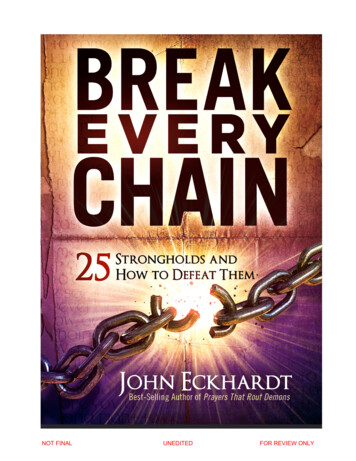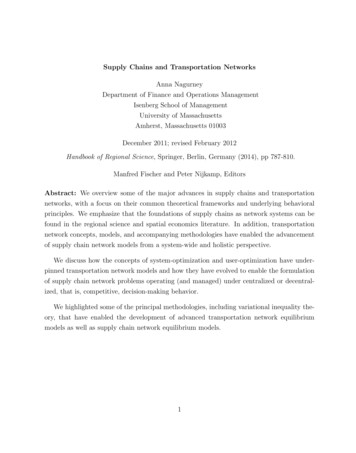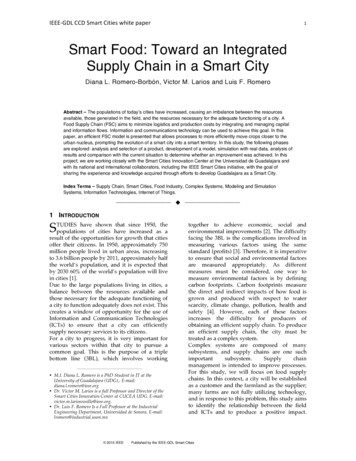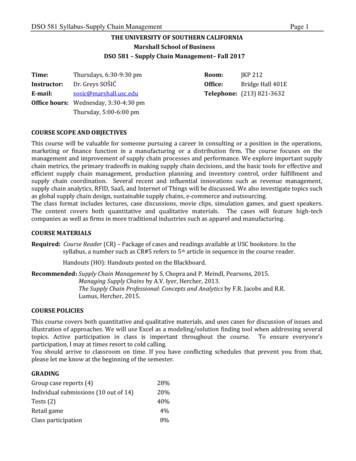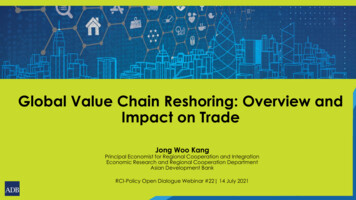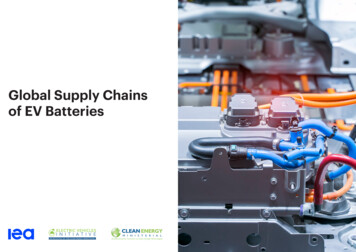
Transcription
Global Supply Chainsof EV Batteries
INTERNATIONAL ENERGY AGENCYThe IEA examines the full spectrum ofenergy issues including oil, gas andcoal supply and demand, renewableenergy technologies, electricitymarkets, energy efficiency, access toenergy, demand side managementand much more. Through its work, theIEA advocates policies that willenhance the reliability, affordabilityand sustainability of energy in its 31member countries, 10 associationcountries and beyond.Please note that this publication issubject to specific restrictions thatlimit its use and distribution. Theterms and conditions are availableonline at www.iea.org/t&c/This publication and any map included herein arewithout prejudice to the status of or sovereigntyover any territory, to the delimitation ofinternational frontiers and boundaries and to thename of any territory, city or area.Source: IEA. All rights reserved.International Energy AgencyWebsite: www.iea.orgIEA member countries:AustraliaAustriaBelgiumCanadaCzech coNetherlandsNew ZealandNorwayPolandPortugalSlovak RepublicSpainSwedenSwitzerlandRepublic of TürkiyeUnited KingdomUnited StatesIEA association oroccoSingaporeSouth AfricaThailand
Global supply chains of EV batteriesExecutive summaryExecutive Summary
Executive SummaryGlobal supply chains of EV batteriesAs electric car sales continue to break records, supply chain considerations move to the foreToday’s battery and minerals supply chains revolvearound ChinaBatteries typically accounts for 30% to 40% of the value of an electricvehicles (EV), and the race to net zero will focus attention on thesecurity of supply of the critical minerals and metals needed toChina produces three-quarters of all lithium-ion batteries and is hometo 70% of production capacity for cathodes and 85% for anodes (bothare key components of batteries). Over half of lithium, cobalt andgraphite processing and refining capacity is located in China. Europeis responsible for over one-quarter of global EV assembly, but it ishome to very little of the supply chain apart from cobalt processing at20%. The United States has an even smaller role in the global EVbattery supply chain, with only 10% of EV production and 7% ofbattery production capacity. Korea and Japan have considerableshares of the supply chain downstream of raw material processing,particularly in the highly technical production of cathode and anodematerial. Korea is responsible for 15% of global cathode materialproduction capacity, while Japan accounts for 14% of cathode and11% of anode material production. Korean and Japanese companiesare also involved in the production of other battery components suchas separators.manufacture them.Electric car sales continued to break records in 2021,testing the resilience of battery supply chainsFew areas in the world of clean energy are as dynamic as EVmarkets. In 2021, EV sales broke new records, with nearly 10% ofglobal car sales being electric, four times their market share in 2019.Public and private spending on EVs doubled relative to 2020. Moreand more countries have pledged to phase out ICEs or haveambitious electrification targets. Five times more EV models wereavailable in 2021 relative to 2015, and most major carmakers areannouncing plans to further accelerate electrification of their fleets.China accounted for half of the growth of the EV market in 2021. Morevehicles were sold in China in 2021 (3.3 million) than in the entireworld in 2020. Sales in Europe continued to grow robustly (up 65%to 2.3 million) after the 2020 boom, and they increased in the UnitedStates as well (to 630 000) after two years of decline. The first quarterof 2022 showed similar sales trends.Most key minerals are mined in resource-rich countries such asAustralia, Chile and the Democratic Republic of Congo, and handledby a few major companies. Governments in Europe and the UnitedStates have bold public sector initiatives to develop domestic batterysupply chains, but the majority of the supply chain is likely to remainPAGE 2
Executive SummaryGlobal supply chains of EV batteriesChinese through 2030. For example, 70% of battery productionfor other parts of the supply chain – in some cases requiring morethan a decade from initial feasibility studies to production, and thenseveral more years to reach nominal production capacity. Projectedmineral supply until the end of the 2020s is in line with the demandfor EV batteries in the Stated Policies Scenario (STEPS). But thesupply of some minerals such as lithium would need to rise by up toone-third by 2030 to satisfy the pledges and announcements for EVbateries in the APS. For example, demand for lithium – thecapacity announced for the period to 2030 is in China.Battery and minerals supply chains will have to expandten-fold to meet government EV ambitionsThe rapid increase in EV sales during the pandemic tested theresilience of battery supply chains, and Russia’s war in Ukraine hasfurther exacerbated matters with prices of raw materials such ascobalt, lithium and nickel surging. In May 2022, lithium prices werecommodity with the largest projected demand-supply gap – isprojected to increase sixfold to 500 kilotonnes by 2030 in the APS,requiring the equivalent of 50 new average-sized mines.more than seven times higher than in early 2021 due tounprecedented battery demand and a lack of sufficient investment innew supply capacity. Meanwhile, Russia supplies 20% of global highpurity nickel. Average battery prices fell by 6% to USD 132 perkilowatt-hour in 2021, a slower decline than the 13% drop theprevious year. If metal prices in 2022 remain as high as in the firstquarter, battery packs would become 15% more expensive than theywere in 2021, all else being equal. However, the relativeThere are other variables affecting demand for minerals. If currenthigh commodity prices endure, cathode chemistries could shifttowards less mineral-intensive options. For example, lithium ironphosphate cathode chemistry (LFP) does not require nickel norcobalt, but comes with a lower energy density and is therefore bettersuited for shorter-range vehicles. LFP share of global EV batterysupply has more than doubled since 2020 because of high mineralprices and technology innovation, primarily driven by an increasinguptake in China. Innovation in new chemistries, such as manganeserich cathodes or even sodium-ion, could further reduce pressure onmining. Recycling can also reduce demand for minerals. Although theimpact between now and 2030 is likely to be small, recycling’scontribution to moderating mineral demand is critical after 2030. Inthe Net Zero Emissions by 2050 Scenario (NZE), demand growscompetitiveness of EVs remains unaffected given the current oil priceenvironment.Pressure on the supply of critical materials will continue to mount asroad transport electrification expands to meet net zero ambitions.Demand for EV batteries will increase from around 340 GWh today,to over 3500 GWh by 2030 in the Announced Pledges Scenario(APS). Cell components and their supply will also have to expand bythe same amount. Additional investments are needed in the shortterm, particularly in mining, where lead times are much longer thanPAGE 3
Executive SummaryGlobal supply chains of EV batterieseven faster, requiring additional demand-side measures andtechnology innovation. Today’s corporate and consumer preferrencefor large car models such as sports utility vehicles (SUVs), whichaccount for half of all electric models available globally and requiresharing. Governments should ensure traceability of key EVcomponents and monitor progress of ambitious environmental andsocial development goals at every stage of battery and EV supplychains.larger batteries to travel the same distances, is exerting additionalpressure.Ensuring secure, resilient and sustainable EV supplychains will be key to accelerating global uptakeElectrifying road transport requires a wide range of raw materials.While all stages of the supply chain must scale up, extraction andprocessing are particularly critical due to long lead times.Governments must leverage private investment in sustainable miningand ensure clear and rapid permitting procedures to avoid potentialsupply bottlenecks.Innovation and alternative chemistries that require smaller quantitiesof critical minerals, as well as extensive battery recycling, can easedemand pressure and avoid bottlenecks. Incentivising battery“rightsizing” and the adoption of smaller cars can also decreasedemand for critical metals.Governments should strengthen cooperation between producer andconsumer countries to facilitate investment, promote environmentallyand socially sustainable practices, and encourage knowledgePAGE 4
Executive SummaryGlobal supply chains of EV batteriesChina dominates the entire downstream EV battery supply chainGeographical distribution of the global EV battery supply chainMiningMaterial processingCell componentsBattery cellsEVs100%75%50%25%0%LiNiCoChinaGrLiEuropeUnited StatesNiJapanCoKoreaGrDRCCathode AnodeAustraliaIndonesiaBattery production EV productionRussiaOtherIEA. All rights reserved.Notes: Li lithium; Ni nickel; Co cobalt; Gr graphite; DRC Democratic Republic of Congo. Geographical breakdown refers to the country where theproduction occurs. Mining is based on production data. Material processing is based on refining production capacity data. Cell component production is based oncathode and anode material production capacity data. Battery cell production is based on battery cell production capacity data. EV production is based on EVproduction data. Although Indonesia produces around 40% of total nickel, little of this is currently used in the EV battery supply chain. The largest Class 1 batterygrade nickel producers are Russia, Canada and Australia.Sources: IEA analysis based on: EV Volumes; US Geological Survey (2022); Benchmark Mineral Intelligence; Bloomberg NEF.PAGE 5
EV batteries and supply chainsGlobal supply chains of EV batteriesBattery metal prices increased dramatically in early 2022, posing a significant challenge to theEV industry1 022Battery price (indexed 2015 100)Metal price (Indexed values 30 Jun 2015 100)Battery metals prices, 2015 – July 20220BatteryIEA. All rights reserved.Sources: IEA analysis based on S&P GlobalNotes: Lithium prices are from June 2022. Cobalt and Nickel from July 2022PAGE 6
EV batteries and supply chainsGlobal supply chains of EV batteriesEV batteries and supply chainsPAGE 7
EV batteries and supply chainsGlobal supply chains of EV batteriesRecent developments in batteries and critical materialsPAGE 8
EV batteries and supply chainsGlobal supply chains of EV batteriesGlobal battery demand doubled in 2021, driven by electric car sales in China350Battery demand by region, 2015-2021GWh per yearGWh per yearBattery demand by mode, 15 2016 2017 2018 2019 2020 2021PLDVsBus2015 2016 2017 2018 2019 2020 2021ChinaOtherEuropeUnited StatesOtherIEA. All rights reserved.Notes: GWh gigawatt-hours; PLDVs passenger light-duty vehicles; other includes medium- and heavy-duty trucks and two/three-wheelers. This analysis does notinclude conventional hybrid vehicles.Sources: IEA analysis based on EV Volumes.PAGE 9
EV batteries and supply chainsGlobal supply chains of EV batteriesHigh-nickel cathode battery chemistries remain dominant though lithium iron phosphate ismaking a 0%30%30%20%20%10%10%0%LithiumLDV EV cathode sales share, 2017-2021Battery capacity share (%)Mineral content (%)Mineral composition of different battery inium0%LFPIron and P2021OtherIEA. All rights reserved.Notes: LDV light-duty vehicle; LFP lithium iron phosphate; NMC lithium nickel manganese cobalt oxide; NCA lithium nickel cobalt aluminium oxide.Low-nickel includes: NMC333. High-nickel includes: NMC532, NMC622, NMC721, NMC811, NCA and NMCA. Cathode sales share is based on capacity.Sources: IEA analysis based on EV Volumes.PAGE 10
EV batteries and supply chainsGlobal supply chains of EV batteriesBattery demand for EVs doubled in 40 gigawatt-hours (GWh) in 2021, more than twice the level of 2020.This increase is driven by the increase in electric passenger carsEVs, consumer electronics, and stationary storage batteries over thenameplate capacities of all battery plants, the global averageutilisation rate for battery factories was 43% of nameplate capacity in(registrations increased by 120%). The average battery capacity ofbattery electric vehicles (BEVs) was 55 kilowatt-hours (kWh) in 2021,down from 56 kWh in 2020, whereas the average capacity increasedfor plug-in hybrid electric vehicles to 14 kWh in 2021, up from 13 kWh2021, up from 33% in 2020. The low global average utilisation rate isexplained by two primary factors. First, there was strategic earlyinvestment in battery plant capacity to prepare for projected demandgrowth. Second, some factories are still ramping up productioncapacity to reach nameplate capacity, a process that can take fromthree to six years.in 2020. Battery demand for other transport modes, includingmedium- and heavy-duty trucks and two/three-wheelers, increasedby 65%. Average battery capacities for BEV light-duty vehiclesNickel-based battery chemistries remain dominantchanged regionally, with increases of more than 10% occurring inKorea and several European countries. 1China experienced unprecedented growth and accounted for thelargest share of automotive battery demand, with almost 200 GWh ofbattery demand in 2021, up 140% from 2020. Growth was alsoimpressive in the United States where demand more than doubled in2021, albeit from a lower base. Europe’s demand growth was slightlylower than last year, yet it still increased more than 70%.The surge in battery demand was met in 2021 due to sufficient batteryfactory capacity. The nameplate capacity of a factory is the intendedfull-load sustained output of a facility. Calculated as total demand of1This report is an excerpt from the Global Electric Vehicle Outlook 2022PAGE 11A key defining feature of batteries is their cathode chemistry, whichdetermines both the battery performance and its material demand.For the automotive sector, three broad categories of cathodechemistry are most relevant today: lithium nickel manganese cobaltoxide (NMC); lithium nickel cobalt aluminium oxide (NCA); and lithiumiron phosphate (LFP). NMC and NCA cathodes have becomeincreasingly dominant as they offer high energy density based onhigher nickel content in the cathode. Higher nickel content, however,requires more complex and controlled production processes. LFP isa lower cost and more stable chemistry, with lower risk of catchingfire and a longer cycle life. It typically only has 65 - 75% of the energy
EV batteries and supply chainsGlobal supply chains of EV batteriesBattery cathode and anode material demandktdensity compared with a high-nickel NMC such as NMC811, althoughrecent technology innovations have significantly improved theirenergy density. NCA is used exclusively by Tesla.Nickel-based chemistries, such as NMC and NCA, were dominant inthe electric car battery market in 2021 with 75% of cathode materialdemand share due to their advantages for driving range. However,there has been a major resurgence of LFP over the last two years,reaching an EV cathode material demand share of 25%, mainlydriven by the increased uptake of electric cars in China. LFP is stillused for most medium- and heavy-duty vehicle applications due to itssuperior cycle life, which suits intensive usage and frequent charging,and the fact that most electric medium- and heavy-duty vehicles arein China, where LFP is mainly used. The cost advantages for LFP inChina became more apparent recently as subsidies that favoured5002500Anode20172018Other cathode20192020Nickel-based cathode2021LFP cathodeIEA. All rights reserved.Notes: kt kilotonnes; LFP lithium iron phosphate. Nickel-based cathodeincludes: lithium nickel manganese cobalt oxide NMC333, NMC532, NMC622,NMC721, NMC811; lithium nickel cobalt aluminium oxide (NCA) and lithiumnickel manganese cobalt aluminium oxide (NMCA).Sources: IEA analysis based on EV Volumes.high-nickel chemistries were phased out.Cathode and anode demand surged alongside battery demand in2021. Demand for cathode material reached 520 kilotonnes (kt),more than doubling from 2020. Demand for anode material alsodoubled to reach 300 kt. The significantly higher material requirementfor cathode material is due to the much higher energy densities of thegraphite anodes in comparison to leading cathodes, thus requiringless anode material per cell.PAGE 12
EV batteries and supply chainsGlobal supply chains of EV batteriesResurgence of LFPNickel-based chemistries retained dominance of the market in 2021with 85% of EV battery demand. However, there has been a majorLFP production is mostly limited to China – the traditional main hub –for the LFP battery chemistry. One reason for this is LFP patents;resurgence of LFP battery chemistries over the last two years with15% of EV battery demand in 2021, doubling from 7% in 2020,primarily driven by increasing uptake of LFP in electric cars inChina. LFP demand share in LDVs in China more than doubled fromthe research consortium owning the patents formed an agreementwith battery makers in China in which they would not be charged alicence fee for using LFP if only used in China. These patents andlicence fees are set to expire in 2022 making production and sales11% in 2020 to 25% in 2021, despite the lower energy density ofLFP than high-nickel chemistries. Given high battery metal prices,LFP has become more attractive as it contains no cobalt or nickel,instead using low cost iron and phosphorous (though remainingexposed to rising lithium prices). LFP relies on lithium carbonaterather than hydroxide used for nickel-rich chemistries.abroad more attractive. Another key reason is the early subsidies inthe LFP supply chain in China.The cost advantages of LFP in a high commodity price market areone reason for the resurgence. Another is the recent innovation ofcell-to-pack (CTP) technology, eliminating the need for modules tohouse cells in the battery pack, thereby reducing the dead weight inLFP battery production is now planned in Europe and the UnitedStates to meet anticipated LFP demand for EVs in these regions.the pack and improving the energy density of LFP batteries. CTPtechnology was pioneered by BYD with the Blade battery and itcontinues to be improved. CATL released their third-generationCTP battery increasing the LFP pack energy density to around 85%of a conventional NMC811 battery. CTP is also being applied tohigh-nickel chemistries to further improve their energy density.LFP is now set to surge globally. Recently, major non-Chinese EVmanufacturers, such as Tesla and Volkswagen, announced movesto LFP chemistries for entry-level high volume EV models. Almosthalf of all Tesla EVs produced in the first-quarter of 2022 used LFP.A surge in LFP poses a challenge for battery recycling as it is difficultto make a profit recovering iron and phosphorous. Without valuablemetals such as nickel and cobalt, the value that can be recoveredfrom LFP batteries drops considerably from conventional recyclingmethods and its economic viability is a concern. LFP appears torequire direct recycling to be profitable or will require regulatoryintervention, frameworks or alternative business models.PAGE 13
EV batteries and supply chainsGlobal supply chains of EV batteriesBattery metal prices increased dramatically in early 2022, posing a significant challenge to theEV industry1 022Battery price (indexed 2015 100)Metal price (Indexed values 30 Jun 2015 100)Battery metals prices, 2015 – July 20220BatteryIEA. All rights reserved.Notes: Lithium prices are from June 2022. Cobalt and Nickel from July 2022Sources: IEA analysis based on S&P Global.PAGE 14
EV batteries and supply chainsGlobal supply chains of EV batteriesSignificant battery metal price increases in 2022 reflect concerns of tightening supply andunderinvestmentHigh battery demand has spurred significant increases in demand forkey metals used in their production. Between the start of 2021 andMay 2022 lithium prices increased more than sevenfold and cobaltprices more than doubled. Nickel prices almost doubled over theCobalt prices are also up sharply in recent months, although they arenot yet at at the level experienced at its peak. This likely reflects lowerdemand expectations due to low cobalt chemistries gaining batterymarket share. Supply issues, such as disruptions in port operationsin South Africa caused by the pandemic and civil unrest alsocontributed to the cobalt price increases.same period reaching levels not seen for almost a decade.The unprecedented battery metal price rises have been caused by acombination of surging battery demand, increasing pressure onsupply chains and concerns around tightening supply. The supplyconstraints have been driven by three trends: first, productionchallenges caused by the pandemic; second, concerns aroundClass 1 nickel supply from Russia; and third, structuralunderinvestment in new supply capacity during the three yearspreceding 2021 when metal prices were low. Some producersdelayed or even curtailed planned projects and expansions due tolow lithium prices. For example, the Australian mining companyGalaxy Resources reduced lithium mine production at its mostimportant mine by about 40% in 2019 as did other Australian lithiummining companies. The last time there was a price surge in batterymetal prices was for lithium and cobalt in 2017 due to optimisticexpectations for growth in battery demand, before prices collapsed inNumber of drillsQuarterly drilling activity by commodity type, 1Q2Q3Q4Q12020Q2Q3Q42021IEA. All rights reserved.Sources: IEA analysis based on S&P Global.In March 2022 the price of nickel reached record levels andexperienced highly volatile movement, causing the London MetalExchange to temporarily close trade for the commodity. This wasprimarily driven by a short squeeze by market players, but recent2018. Lithium has reached unprecedented price levels today beingalmost 200% higher than its previous peak.PAGE 15
EV batteries and supply chainsGlobal supply chains of EV batteriesconcerns about the supply of nickel from Russia due to its invasionof Ukraine has also fuelled price rises. Russia is the world’s largestproducer of battery-grade (Class 1) nickel.increase in adoption, over nickel-rich chemistries. Second,commodity prices were relatively low for the first half of 2021 whichhelped the average price decline. Third, the use of higher nickelchemistries such as NMC811 reduced the use of cobalt, the mostPrice increases are usually followed by expansion in supply with newmines or life extension of existing ones. Drilling activity is an indicatorof exploration in the mining sector. Since battery metal commodityexpensive metal constituent in batteries per kilogramme (kg) (cobaltis around 5% of NMC811 cell price based on 2021 average price),also offsetting some costs, particularly in the first half of 2021.prices have begun to rise, so have drill counts (from 2020 to 2021, 50% for nickel and a threefold increase for lithium). High prices maytherefore be a long-term benefit for future battery metals supply,stimulating significant supply investment to compensate for theHowever, a key reason is the impact of rising commodity prices hasyet to fully materialise. Automakers increasingly use contracts inwhich material costs are linked with commodity prices for high volumebattery orders, though, there is a time lag. Therefore, theseautomakers did not feel the result of the exceptional commodity pricerises from the last three months of 2021 until the first-quarter of 2022.underinvestment during the years of low commodity prices.Batteries have yet to experience the full impact ofcommodity price surgesIf metal prices were to remain at levels experienced in the first threemonths of 2022 throughout the rest of the year, then we estimate thatbattery pack prices might increase by up to 15% from the 2021weighted average price, all else being equal. The impact is likely tobe mitigated by OEMs substituting other more cost-effectivechemistries, but these price increases nonetheless will pose majorchallenges for automakers, increasing battery costs, decreasingDespite the recent commodity price surge, battery prices still declinedin 2021 with BNEF’s annual battery price survey recording a salesweighted average price of USD 132/kWh, a 6% decrease from 2020.Although this represents a significant reduction from the 13%decrease from 2019 to 2020, there are several factors that partiallyinsulated the average battery price from the commodity price riseslast year. First, the rising prices incentivised chemistry substitutions.Many automakers switched to lower cost cathode chemistries withless commodity price exposure, such as LFP, which saw a significantmanufacturer margins and raising costs for consumers.PAGE 16
EV batteries and supply chainsGlobal supply chains of EV batteriesEV batteries are the main demand driver for lithium demand, but their importance is also rapidlyrising for cobalt and nickelBattery metals demand, 2017 - 202180180160701406012050100408030602040102002017 2018 2019 2020 2021EV demandOther batterieskt Nikt Cokt Li90NickelCobaltLithium03 0002 5002 0001 5001 0005002017 2018 2019 2020 2021Ceramics and glassOtherMetals02017 2018 2019 2020 2021Class 2 demandClass 1 non-EV demandIEA. All rights reservedNotes: Class 1 nickel ( 99.8%) is suitable for use in batteries and Class 2 nickel ( 99.8%) is not applicable for use in batteries without significant further processing.Other batteries includes: batteries for stationary storage and consumer electronics.Sources: IEA analysis based on EV Volumes and S&P Global.PAGE 17
EV batteries and supply chainsGlobal supply chains of EV batteriesCritical metal demand and prices are increasingly driven by batteriesThe three most critical metals for Li-ion batteries are lithium, cobaltand nickel. All three metals are abundant in the earth’s crust,however, supply depends on mine production capacity. Theto higher nickel content chemistries to achieve higher energydensities and lower costs (cobalt is the most expensive constituentper kg of Li-ion battery metal). The additional concerns of humanrights abuses and child labour related to cobalt mining in theDemocratic Republic of Congo (DRC) have also motivated batterymakers to move away from cobalt-intensive chemistries.exceptional rise in demand for batteries is now outstripping supply,with new mines not being built fast enough.LithiumNickelLithium demand has almost doubled since 2017 to 80 kt in 2021, ofwhich demand for EV batteries accounts for 47%, up from 36% in2020 and only 20% in 2017. Lithium is also used in the production ofceramics, glass and lubricants. Batteries are now the dominant driverof demand for lithium and therefore set the price. The availability oflithium supply is of particular concern because it is irreplaceable forLi-ion batteries and there are no commercial alternative batterychemistries available at scale today that meet the performance of Liion batteries. Alternative lithium-free chemistries, however, aremaking progress, for instance, with Na-ion being commerciallyintroduced by CATL in 2021.Nickel demand is dominated by stainless steel production. Totaldemand was 2 640 kt in 2021, of which the share of EV-relateddemand was 7%, up from 4% in 2020. Batteries requireClass 1 nickel ( 99.8% purity), while Class 2 nickel ( 99.8% purity)cannot be used without further significant processing. Nickel-basedcathodes are the dominant EV battery chemistries today and areexpected to remain so in the future due to the demand for longerdriving range EVs particularly in Europe and the United States. Thereis almost seven times more nickel than lithium by weight in anNMC811 battery, therefore, EV Li-ion battery prices are mostsensitive to nickel prices. This is of significant current concern giventhe war in Ukraine because Russia is the world’s largest supplier ofCobaltCobalt demand was 170 kt in 2021, of which the EV battery sharewas 24%, up from 18% in 2020. Cobalt is also used in superalloys,hard metals and catalysts. The cobalt intensity of Li-ion batteries hasdecreased significantly over recent years as battery makers movedClass 1 battery-grade nickel, producing around 20% of global supply.PAGE 18
EV batteries and supply chainsGlobal supply chains of EV batteriesMaking batteries for EVs requires several stagesEV battery supply chainIEA. All rights reserved.PAGE 19
EV batteries and supply chainsGlobal supply chains of EV batteriesProduction in all stages of the EV battery supply chain is concentrated in few companiesShare of total production of top-three companies at each stage of the EV battery supply chain, 2021MiningCell ComponentsBattery cellsEVs100%75%50%25%0%LiNiCathode AnodeBattery productionEV productionIEA. All rights reserved.Notes: The figure shows production percentages of top-three companies for 2021: EV production by sales; battery production by MWh produced; cathode and anodeby production capacity; mining by production capacity. Top-three compan
IEA association countries: Argentina Brazil China Egypt India Indonesia Morocco Singapore South Africa Thailand. Global supply chains of EV batteries Executive Summary Executive summary . Global supply chains of EV batteries PAGE 2 Executive Summary
